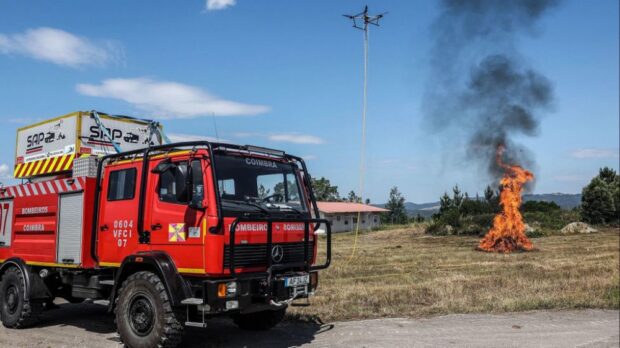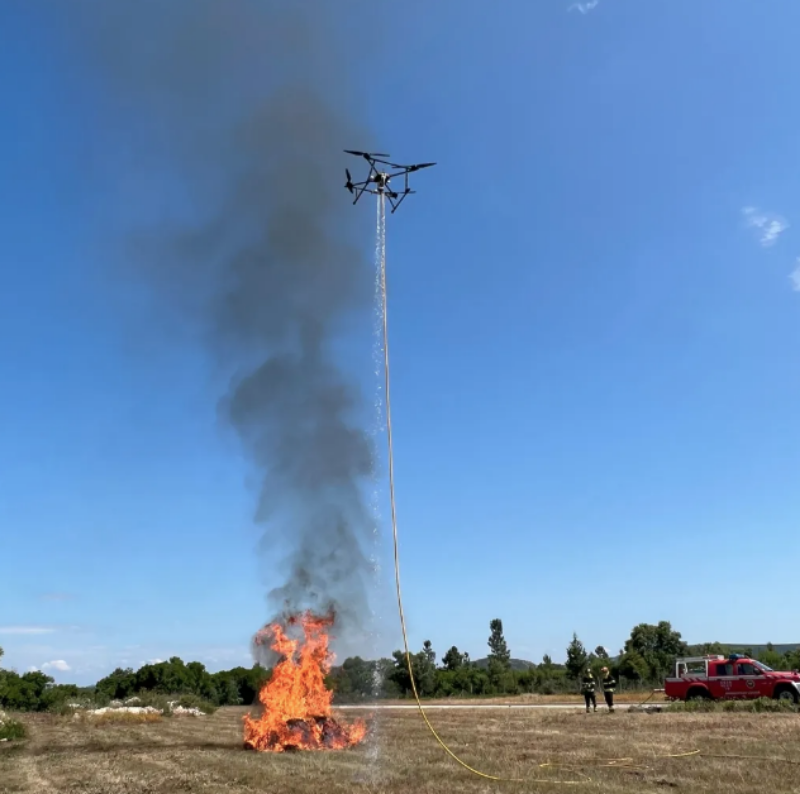On a still, hot May afternoon in central Portugal, a car-sized pile of brush catches fire. As the flames leap higher, a torrent of water suddenly falls from the sky. It’s not rain, however. A large drone hovers about 15m (49ft) above, a fire-proof hose dangling from its belly.
A pair of jets on either side of the hose pummel the flames with water as the drone operator controls the device from behind a fire truck, the device’s water source. In about two-and-a-half minutes, the fire is out.
The 21kg (46lb) drone, called Sap (for “ported nozzle system” in Portuguese) is one of the newest tools in the battle to beat back extreme wildfires. The drone is lightweight, easy to operate and nimble at low altitudes. With a wingspan of 2.14m (7ft) and made primarily of carbon fibre, can swoop into places that are too dangerous or too difficult for firefighters to enter, says Carlos Viegas, a mechanical engineer who heads the University of Coimbra’s Field Tech Lab and co-led the project.
“It’s the future of firefighting,” he says on his way from Coimbra to the demonstration site in Lousâ, steering his black electric car past mountain slopes spackled with eucalyptus. “We’re trying to bring robotics technology to wildfire management. Because every opportunity we have to keep people from dying during firefighting, we need to try.”
The drone, inspired in part by flyboarding, is part of a global quest to devise new technologies that can help improve how wildfires are detected and stopped. Like many other communities across the world, Lousā lives in anticipation of the next blaze. About 70% of the municipality is forest.
At the demonstration site, adjacent to the University of Coimbra’s Forest Fire Research Laboratory – considered one of the most important fire research facilities in Europe – emerald mountains rise in the distance, thick with new spring growth. A row of wind turbines rise above them.
To the south and east of here, in 2017 two major wildfire events killed 117 people, including one firefighter. The first, sweeping through Pedrógão Grande in June, killed 66 people, injured 253 others, and scorched 53,000 hectares (131,000 acres). According to a 2019 study, climate change left its fingerprints on the blazes, in the form of abnormal drought and heat that year. “I think 2017 was an eye-opener for us,” Viegas says.
Many of the nation’s native forests have evolved to withstand fire and in some cases need it, but much of that forest has been replaced with eucalyptus – an Australian tree first planted in Portugal in the 1830s – or pine plantations. The area covered by eucalyptus in central Portugal doubled between 1995 and 2018.
Maria Araújo, an engineer with Jacinto, a Portuguese fire truck company that partnered with two other companies and the University of Coimbra on the project, says that for many on the team, the project holds personal significance.
“A lot of firefighters are workers at Jacinto as well… We really want to eliminate the risk for firefighters.”
While the demonstration in Lousâ took only minutes, the prototype took almost four years to develop. The first hose the team tried burned up. The nozzle had to be tweaked to create pressure strong enough to effectively douse the fire. But the strong pressure burst the PVC nozzle, so the team went with heavier but more durable stainless steel instead. And after several tests, they figured out that two symmetrical jet streams, one on either side of the nozzle, were needed to keep the craft steady and balanced while it hovered up to 50m (164ft) above the flames.
The team is now applying for grants and talking with potential collaborators to turn the prototype into a product that emergency response outfits can add to their fire-fighting arsenal. The current prototype can only stay aloft for 17 to 24 minutes, and Viegas says it needs a €50,000 (£43,000/$53,000) makeover to be ready for widespread use.
“We want to make it more user-friendly,” mechanical engineer Rafael Batista of Sleeklab, the development lab that designed the drone, says. “It’s so large that it’s very easy to manoeuvre, but it requires someone very calm and specialised.”
Even with a bigger motor and other improvements, the drone’s best use will likely still be taming early or late stage fires, he adds – it won’t replace conventional aerial firefighting equipment such as manned helicopters and “water bomber” aircraft.
“For [these], the drone won’t be doing anything because the fire is so out of proportion already that this won’t be useful.”
All big fires begin as small ones, though, and researchers have found that early suppression, which this type of drone could help with, is crucial when tinderbox conditions exist.
Still, the firefighting drone is very early stage – and has only been used so far on a test fire, not the real thing.
Erik Litzenberg, senior wildfire policy advisor at the International Association of Fire Chiefs based in Virginia, US, says that, from a wildland perspective, he believes the drone has limited applicability.
“Just about any tool could help save lives in wildland and wildland urban interface firefighting, and every existing or potential tool is worthy of exploration,” he says. “[But] fire hose and water are quite heavy, so I believe the amount of water that could be delivered through this design would be limited. It takes quite a bit of water to extinguish a wildland fire in all but the very early phases.”
He adds that the design appears to need to be relatively near a water source, which would also limit its use in wildland fires that are hard to access.
“Perhaps its use in fires that are ‘too dangerous to approach’ is more useful – such as fires involving chemicals or explosives,” he adds.
The BBC also reached out to multiple other sources for comment on the usefulness of the technology in practice, and several said they could not comment on the project as they had not been involved, making it hard to know how useful it would be, or had policies of not commenting on products.
On the way back to Coimbra, successful drone demonstration complete, Viegas points out a crew of workers along the left side of the road. They’re removing shrubs, trees and tall grasses, creating a buffer between the road and the forest, part of Portugal’s post-2017 strategy to reduce wildfire risk.
Even with all the recent advances in firefighting technology, the best defense is to keep megafires from happening in the first place.
One cigarette butt tossed out a car window can be all it takes to spark a conflagration – and the more potential fuels are cleared away, the less firefighters will need a drone to protect them from small, hard-to-reach fires that turn into extreme ones.
Photos: April Reese
Source: BBC



